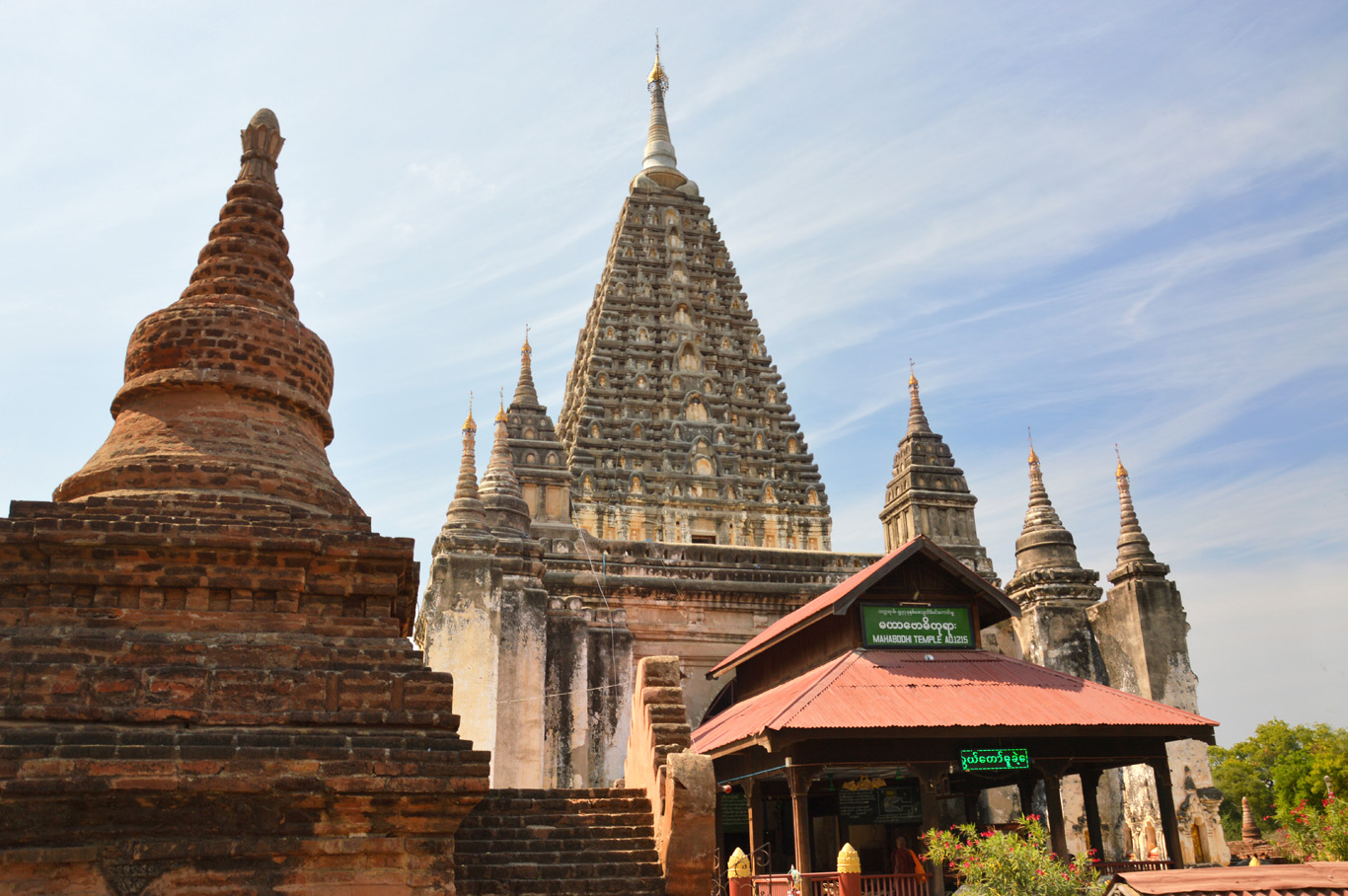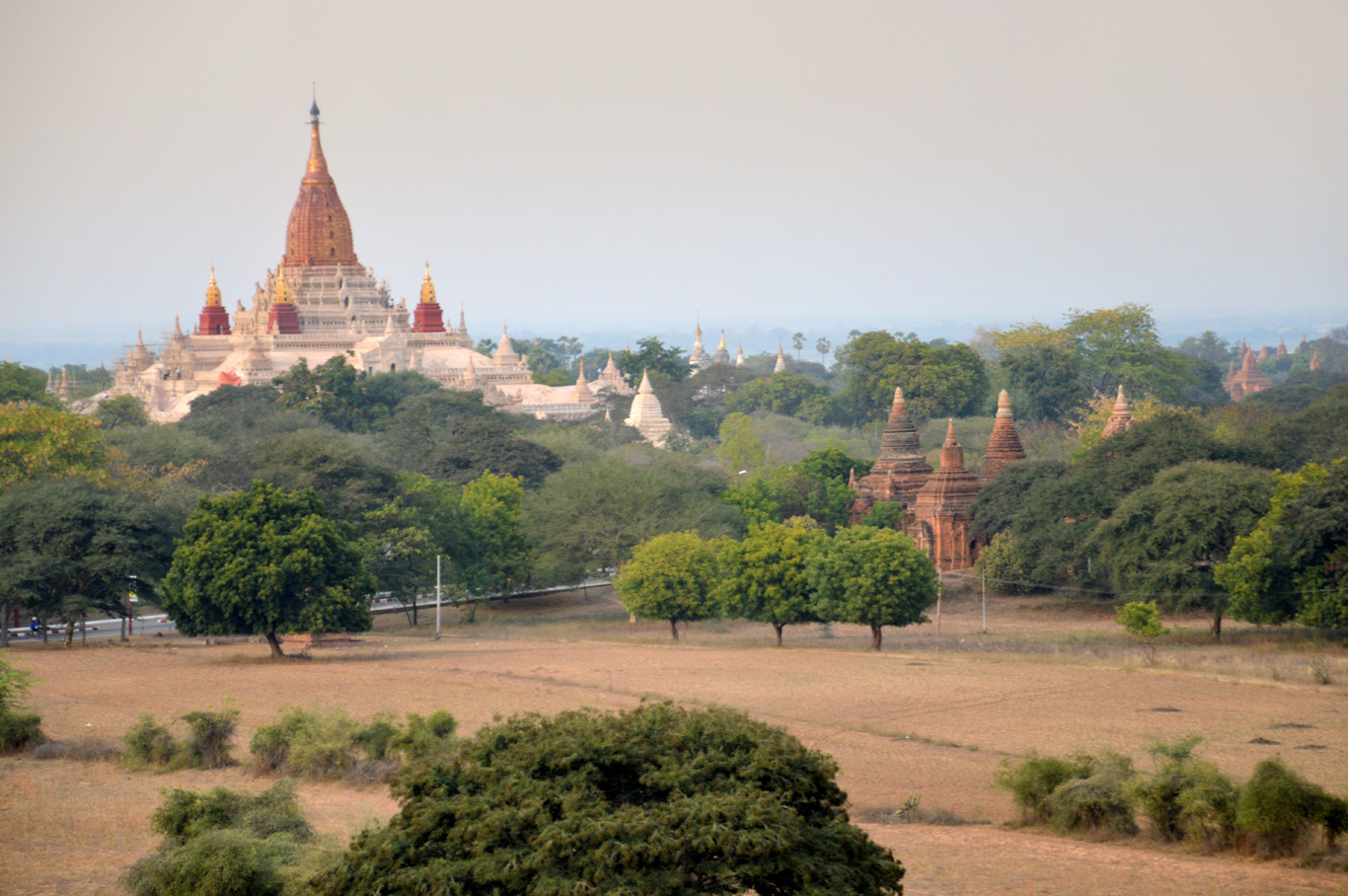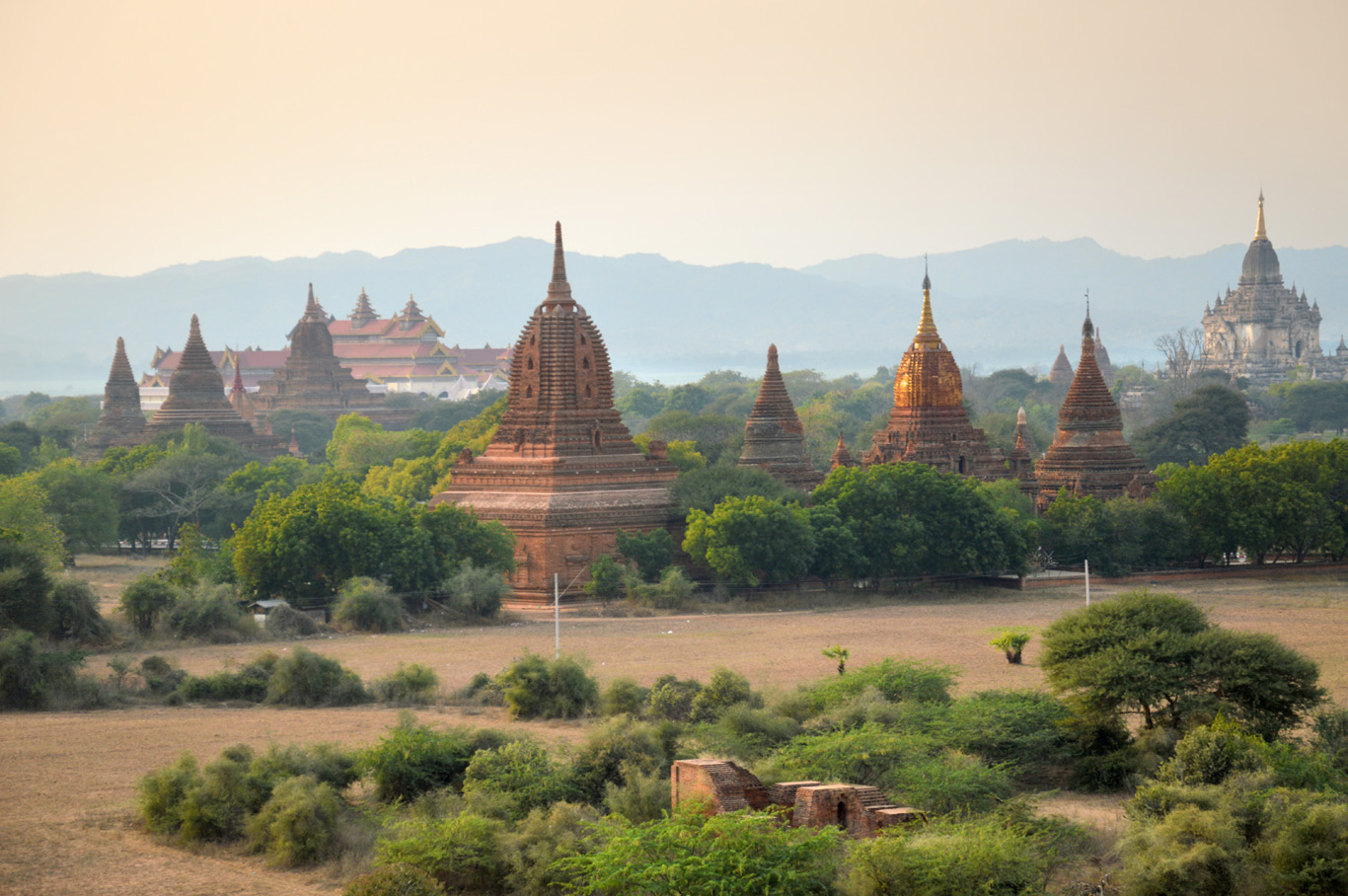Old Bagan is one of the most famous archaeological sites in South East Asia. Often compared to the Angkor Wat Complex in Cambodia, Bagan was open to the tourists relatively recently. Although Myanmar is still regarded by some as an off the beaten path destination (for example, there are not that many foreign visitors in Mandalay or at the Golden Rock Pagoda), the magnificent temples of Bagan attract hundreds of travelers every day. Nevertheless, just like Angkor Wat, the pagodas in Bagan are spread around such an enormous area that you'll still feel the uniqueness and remoteness of this extraordinary site.
How to get to Bagan
There are many ways to reach Bagan: you can go on a long, overnight bus journey from Yangon (which is actually very pleasant - buses are extremely modern and comfortable, although some people discourage from doing so) or from Mandalay which is located around 180 km (110 miles) from Old Bagan (4 hours). It is also possible to take a ferry down the Irrawady river - it's pleasant but it will take all day.
We arrived in Bagan from Mandalay (which is also a nice city with a traditional touch - I'll describe it soon). At the reception of our hotel in Mandalay, we asked for a bus station and what time the bus to Bagan departs. The staff replied that we didn't have to go to the bus station - there would be a transfer waiting for us in the evening. The journey cost us 11 USD (9.50 EUR) each. Note that accommodation in Myanmar is more expensive than in Thailand or Cambodia - there are still very few hostels there.
In the evening, the car came, and together with a couple of local people, we got in and headed off. Initially we thought the car would go the bus station in order for us to catch a bus but as it turned out, we went all the way to Old Bagan and were dropped off right at our guest house. I am aware that the public bus is cheaper but it wouldn't take you directly to Old Bagan - it will stop in New Bagan and from there you must take a taxi to wherever you're staying.
How to get around Bagan
In Myanmar, from what I experienced, everything is still relatively more straightforward and honest than in Thailand or Cambodia. There were no con artists trying to "hunt" tourists and forcing them into buying something. At least we didn't encounter any. You just ask what you need in the hotel and you get a straight answer. The locals seem also friendlier, less fake and didn't look down on the tourists.
Don't be shocked when you see someone seemingly spit out blood! It's a habit of chewing betel nut - I've described it more in the post about our crazy journey to the Golden Rock Pagoda.
There are a few ways to get around Bagan. As it is quite a large area, and there is no possibility of walking in order to see the most important temples so you can purchase one of the following tours: a taxi tour with an English speaking driver (around 30 USD), a horse cart tour (10-15 USD) or a hot air balloon flight (320 USD). We did a balloon flight in Cappadocia in Turkey and loved it so much that we decided to splurge again in Bagan. We'd found a cheaper than usual flight online and booked it in advance (for 292 USD) but from what I know, all the other tourists paid over 320 USD. Unfortunately, we were a bit disappointed with the flight and we wouldn't do it for the second time. I've written about it in this post.
The last, cheapest and best option, in my opinion remains a bicycle! For only around 2 USD for a day, you can rent a bike and cycle all over the area at your own pace - you can visit individually whatever you wish. You can stop at the smaller and less visited temples, experience the local life and feel like a pioneer! Right after the balloon flight, we did exactly that: rented the bikes and cycled around the entire area. If you're too lazy or tired to cycle, rent an e-bike. It is advised to do it early in the morning as the heat later can be difficult to bear.
Bupaya Pagoda
Gawdan Palin Temple
Gawdan Palin Temple
Local village
Small temples among the fields
Mahabodhi Temple
Thatbyinnyu Temple
Hsu Taung Pyi Pagoda
Min O Char Thar Pagoda
Pottery market
Local woman
Ananda Temple
Ananda Temple
Buddha Temple in Ananda Temple
Htilominlo Temple
Local shepherds
Cattle among the temples
Cycling in Bagan
Local huts
Golden stupa at Shwezigon Temple
Shwezigon Temple
Dhammayangyi Temple
Sulamani Temple
Map of Old Bagan
The most important Temples in Bagan and best sunset view
The first temple that we saw was the golden stupa of Bupaya Pagoda which is located by the river, in the north of Old Bagan. We had a chance to visit it on the night we arrived - our driver (from Mandalay) dropped the local passengers there. The temple is small and not one of the main and famous but it looked beautifully, especially at night. So, you can skip it and follow the route below.
The next morning, we started visiting Old Bagan by cycling up north Bagan-Chauk Road. Then, we headed west and down south towards Anawrahta Road and back to Bagan-Chuak Road (see the map). It all depends where your hotel is located.
Although you're going to see literally thousands of little pagodas everywhere you turn (originally there were over 13,000!) - there are some larger, more magnificent that stand out. They all date back to the 11th-12th century.
One of the first large temples we saw was Gawdaw Palin Temple - spectacular, second highest temple in Bagan, dating back to the 13th century. It was heavily damaged during the earthquake in 1975 but it's been restored and now you can admire its full glory.
Next one was Mahabodhi Temple, a temple also from the 13th century, archaeological design of which was inspired by the Mahabodhi Temple in Indian city of Bihar. Thatbyinnyu Phaya is Bagan's tallest, 12-th century temple, located near one of the most famous pagodass in Bagan - Ananda. It's magnificent and way less touristic than Ananda.
The aforementioned Ananda Temple which dates back to the beginning of the 12th century is still open to the public for worship to this day. It's beautifully maintained and inside you can find a golden statue of Buddha. One of the most popular.
Between Ananda and Thatbyinnyu we saw a pottery market, numerous smaller temples (Hsu Taung Pyi and Min O Char Thar) as well as locals with their herds of cattle.
Heading westwards towards the town of Nyaung-U we visited the large, red brick Htilominlo temple dating back to the 13th century.
In the town of Nyaung-U, you can visit the largest temple complex of Bagan - Shwezigon. It doesn't resemble the other abandoned temples - although it was completed in 1102, it's now attended by worshipers and has the modern feeling of other pagodas of this type - full of golden stupas and visited by many pilgrims.
From Shwezigon, we cycled back all the way south and stopped at another brick temples - Dhammayangyi Temple and Sulamani Temple from the 12th century. The scenery around would be perfect for an adventure film.
Our last stop was the famous sunset temple - Shwesandaw Pagoda. One of the tallest and oldest in Bagan (11th century). And what's best - you can climb its 5 terraces that offer unforgettable view over the area - especially at the sunset when the dusty and smoky air has an orange hue giving it a mythical atmosphere. If you though at first that Bagan is off the beaten track, now you'll see hundreds of tourists. Good news is that it's quite difficult to climb the temple up to the highest level as the steps are incredibly steep and narrow. The views are so amazing that if you didn't take the balloon flight - you didn't loose much! Don't miss this pagoda!
How to avoid paying entry fee in Bagan
In general, the entry fee in Bagan is quite expensive: 20 USD or 20 EUR. Of course, the best option is to pay in dollars (it's even better to pay in dollars than in local currency). The thing about Bagan is that it doesn't have an entrance or a gate where you have to purchase the tickets. If you cycle from Bagan-Chauk Road, you will not see any office or a place where you would have to pay the fee.
Basically, you can enter the site completely free. The inspectors that collect the payments and issue the tickets stand by the sunset temple - Shwesandaw. We actually completely forgot at that point that there is an entry fee! We arrived at Shwesandaw from behind and were asked to pay by the officers when only while leaving the temple - through the main front gate.
If we'd returned the way we arrived, from behind and cycled around, we wouldn't have had to pay anything at all.
Is it worth it? Pros and cons of visiting Bagan
The simple answer is yes. The whole area is even more spectacular in real life that in the photos. And even though it's so popular with many tourists, when you rent a bike, you'll have a lot of freedom and barely ever spot any foreigners.
There are literally thousands of temples in Bagan. Although I featured many of the most popular temples in this posts, while cycling around you'll discover amazing, smaller structures that will surely enchant you. I liked the site as much as Angkor Wat, although I must admit, I felt more free and safer in Bagan.
The whole site has definitely more pros than cons. The entry price may be a bit disadvantageous but there are tricky ways to avoid paying it. The only things that bothered me were the extreme contrast between luxurious, western-style hotels located right beside little, poor villages and unbelievable pollution.
Air pollution, to be exact: when you visit Bagan during the dry season, the fields and bushes are being burnt out everywhere. All this, combined with the dust create a thick layer of smog that sometimes can be really irritating. You can feel it in your throat. You'll be able to see the layer of smoke clearly from a hot air balloon.
Shwesandaw Pagoda - the sunset temple
View from the sunset temple over Dhammayangyi Temple
View of Ananda Pagoda
With the view over Bagan
Temples in Bagan - Thatbyinnyu Temple in the background
View from the sunset temple (although it looks like from a balloon)
View from the sunset temple
View from the sunset temple - Thatbyinnyu Temple in the background
Balloons over Bagan
Speaking about the hot air balloons, that was the last disappointing thing about Bagan. The service was good, everything went as expected, however it's the price was high - 300 USD. The views were nice but not much more spectacular than the panorama you can admire from the sunset temple. I've written an honest review about my experience of the hot air balloon over Bagan in this article.
If you liked this article, you can also download it via the GPSmyCity app - you will be able to gain access to the guide, which will direct you to all the attractions described above, even if you're offline. Download it here.
Related Posts
Copying without permission is not allowed. If you wish to use any of the site's content (photos or text) or work with us, please contact us.
We welcome questions, advice, support or criticism. However, spam comments will be removed.







































